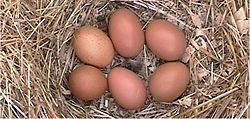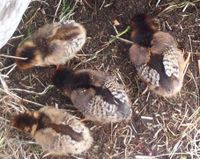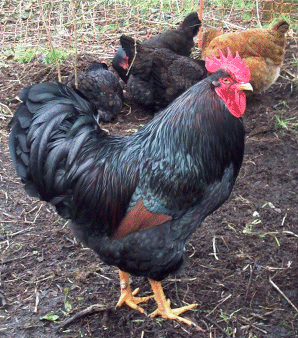
Barnevelder
Encyclopedia

Chicken
The chicken is a domesticated fowl, a subspecies of the Red Junglefowl. As one of the most common and widespread domestic animals, and with a population of more than 24 billion in 2003, there are more chickens in the world than any other species of bird...
named after the Dutch
Netherlands
The Netherlands is a constituent country of the Kingdom of the Netherlands, located mainly in North-West Europe and with several islands in the Caribbean. Mainland Netherlands borders the North Sea to the north and west, Belgium to the south, and Germany to the east, and shares maritime borders...
town of Barneveld
Barneveld
Barneveld is a town and a municipality in the province of Gelderland in the center of the Netherlands. It is known for its poultry industry and large protestant community. The population of the municipality was 52.629 in June 2010, the town having a population of 29.756.-Transport:Barneveld is...
.
It is a cross of 19th century Dutch landrace chickens with Asian breeds imported to Europe in the mid-late 19th century such as the Brahma
Brahma (chicken)
Brahmas are an Asiatic breed of chicken, originating in the Brahmaputra region in India where they were known as "Gray Chittagongs." Their heritage is unclear, but they are believed to be closely related to the Jungle Fowl and the Cochin....
, Cochin
Cochin (chicken)
The Cochin or Cochin China, originally known as the Chinese Shanghai, is a breed of chicken.The name Cochin came from the original Chinese name 九斤黄, meaning nine jin yellow, erroneously conflated with the then-current names for what are now parts of southern India and Vietnam, where jin is a...
, Croad Langshan
Croad Langshan
The Croad Langshan is an old, heavy, soft-feathered chicken breed which probably originated in China.-Origin:The first recorded imports came from the Langshan District in 1872 and were undertaken by Major F.T...
and Malay.
History
Hans Schippers, the Dutch authority on the breed, reports the following on the development of the Barnevelders : Between c. 1850 and 1875 CochinCochin (chicken)
The Cochin or Cochin China, originally known as the Chinese Shanghai, is a breed of chicken.The name Cochin came from the original Chinese name 九斤黄, meaning nine jin yellow, erroneously conflated with the then-current names for what are now parts of southern India and Vietnam, where jin is a...
, Malay, Brahma
Brahma (chicken)
Brahmas are an Asiatic breed of chicken, originating in the Brahmaputra region in India where they were known as "Gray Chittagongs." Their heritage is unclear, but they are believed to be closely related to the Jungle Fowl and the Cochin....
and Croad Langshan
Croad Langshan
The Croad Langshan is an old, heavy, soft-feathered chicken breed which probably originated in China.-Origin:The first recorded imports came from the Langshan District in 1872 and were undertaken by Major F.T...
arrived from Asia and were crossed with local fowl. One particular strain of brown egg laying fowl were like Black Cochins
Cochin (chicken)
The Cochin or Cochin China, originally known as the Chinese Shanghai, is a breed of chicken.The name Cochin came from the original Chinese name 九斤黄, meaning nine jin yellow, erroneously conflated with the then-current names for what are now parts of southern India and Vietnam, where jin is a...
in appearance and were kept as a meat bird (these were not, however, purebred Cochins
Cochin (chicken)
The Cochin or Cochin China, originally known as the Chinese Shanghai, is a breed of chicken.The name Cochin came from the original Chinese name 九斤黄, meaning nine jin yellow, erroneously conflated with the then-current names for what are now parts of southern India and Vietnam, where jin is a...
). Around 1885 these birds were crossed with Brahmas
Brahma (chicken)
Brahmas are an Asiatic breed of chicken, originating in the Brahmaputra region in India where they were known as "Gray Chittagongs." Their heritage is unclear, but they are believed to be closely related to the Jungle Fowl and the Cochin....
and the offspring of this cross was crossed with Langshan
Croad Langshan
The Croad Langshan is an old, heavy, soft-feathered chicken breed which probably originated in China.-Origin:The first recorded imports came from the Langshan District in 1872 and were undertaken by Major F.T...
. In 1898 American utility birds ("Amerikaanse Nuthoenders"), a rough version of the Golden Wyandotte
Wyandotte (chicken)
The Wyandotte is a breed of chicken originating in the United States. The first examples of the breed appeared in 1870s. Wyandottes are a docile, dual-purpose breed kept for their brown eggs and for meat. They appear in a wide variety of color patterns, and are popular show birds. The Wyandotte...
(apparently not dissimilar to the American Winnebago
Winnebago (chicken)
Winnebago is a 19th-century American chicken breed of unknown origin. It appears to have been a precursor to the modern Golden Wyandotte.In by John H...
, a ‘precursor’ to the Golden-laced Wyandotte
Wyandotte (chicken)
The Wyandotte is a breed of chicken originating in the United States. The first examples of the breed appeared in 1870s. Wyandottes are a docile, dual-purpose breed kept for their brown eggs and for meat. They appear in a wide variety of color patterns, and are popular show birds. The Wyandotte...
) were crossed into the developing breed followed in 1906 by Buff Orpingtons
Orpington (chicken)
The Orpington is a breed of chicken named after Orpington, England, which was made famous in part by this breed. Belonging to the English class of chickens, it was bred to be an excellent layer with good meat quality...
. Overall in the development to follow the Croad Langshan
Croad Langshan
The Croad Langshan is an old, heavy, soft-feathered chicken breed which probably originated in China.-Origin:The first recorded imports came from the Langshan District in 1872 and were undertaken by Major F.T...
continued to have the biggest influence and contributed hardiness, brown eggs
Egg (food)
Eggs are laid by females of many different species, including birds, reptiles, amphibians, and fish, and have probably been eaten by mankind for millennia. Bird and reptile eggs consist of a protective eggshell, albumen , and vitellus , contained within various thin membranes...
and good winter production.
A similar account, bar the influence of the "Amerikaanse Nuthoenders", was given in 1930 by P. L. Wijk, District State Poultry Expert, Apeldoorn
Apeldoorn
Apeldoorn is a municipality and city in the province of Gelderland, about 60 miles south east of Amsterdam, in the centre of the Netherlands. It is a regional centre and has 155,000 . The municipality of Apeldoorn, including villages like Beekbergen, Loenen and Hoenderloo, has over 155,000...
and P. Ubbels, State Poultry Consultant, Beekbergen
Beekbergen
Beekbergen is a village in the Dutch province of Gelderland. It is located in the municipality of Apeldoorn, about 5 km south of that city.Beekbergen was a separate municipality until 1818, when it became a part of Apeldoorn....
, The Netherlands in his contribution on The Origin of the Barnevelder and Welsummer Breeds. The authors add that
"[i]n 1899 it was ascertained that the fowls on the farms in the neighbourhood of Barneveld showed some uniformity. This could be explained by the fact that poultry keepers always obtained their setting eggs from the farmers who came to market with the finest eggs, and who as a rule used dark-coloured cocks for breeding."According to Wijk & Ubbels, efforts were made to obtain more uniformity in colour and type from 1910 onwards and the name Barnevelder dates from that time. An Association of Barneveld Breeders was established in 1921 which fixed the standard.
Indian Game (Cornish)
Cornish (chicken)
The Cornish, known as the Indian Game in its native country of Cornwall in England, United Kingdom, is a breed of chicken. Cornish chickens, as well as crosses of Cornishes, are the most-used breed in the chicken meat industry...
may have been crossed into the Barnevelders in Britain sometime after their importation into Britain in the 1920s.
The breed gained worldwide recognition and was exported to many countries because of its ability to lay approximately 180-200 large brown eggs per year.
Characteristics

Body
With regard to living things, a body is the physical body of an individual. "Body" often is used in connection with appearance, health issues and death...
. They are hardy birds and good foragers. While they became famous for their dark brown eggs in the first half of the 20th century most birds now appear to be in the hands of show breeders and not much attention has been given to maintaining the dark brown egg colour or to productivity with the focus being on external characteristics instead. Many flocks now lay eggs of a much lighter brown than before and are sometimes not quite as productive as befits their reputation. They are good winter layers and have a quiet disposition.
Varieties

Double-laced (large fowl)
Late 19th/early 20th century. Bred in Barneveld, Netherlands. History as above.
Double-laced (Bantam)
Recognized in 1931 in Germany. Bred from a 'petite' double-laced hen and a Bantam Rhode Island Red
Rhode Island Red
The Rhode Island Red is a breed of chicken . They are a utility bird, raised for meat and eggs, and also as show birds. They are a popular choice for backyard flocks because of their egg laying abilities and hardiness. Non-industrial strains of the Rhode Island Red are listed as recovering by the...
cock, followed by crossings with Bantam Golden-laced Wyandottes
Wyandotte (chicken)
The Wyandotte is a breed of chicken originating in the United States. The first examples of the breed appeared in 1870s. Wyandottes are a docile, dual-purpose breed kept for their brown eggs and for meat. They appear in a wide variety of color patterns, and are popular show birds. The Wyandotte...
, Bantam German Langshan, and Bantam Indian Game (Cornish)
Cornish (chicken)
The Cornish, known as the Indian Game in its native country of Cornwall in England, United Kingdom, is a breed of chicken. Cornish chickens, as well as crosses of Cornishes, are the most-used breed in the chicken meat industry...
.
Black (large fowl)
1920s. Black came as a sport from the partridge. Black Plymouth Rock and Black Wyandottes
Wyandotte (chicken)
The Wyandotte is a breed of chicken originating in the United States. The first examples of the breed appeared in 1870s. Wyandottes are a docile, dual-purpose breed kept for their brown eggs and for meat. They appear in a wide variety of color patterns, and are popular show birds. The Wyandotte...
were crossed in to achieve pure black.
Black (Bantam)
Recognized in 1954 in Germany. Bred from Black Barnevelders and Bantam Black Wyandottes
Wyandotte (chicken)
The Wyandotte is a breed of chicken originating in the United States. The first examples of the breed appeared in 1870s. Wyandottes are a docile, dual-purpose breed kept for their brown eggs and for meat. They appear in a wide variety of color patterns, and are popular show birds. The Wyandotte...
in Germany.
White (large fowl)
1934. Occasionally occurring recessive white birds were crossed with white Plymouth Rocks and White Leghorn to produce White Barnevelders.
White (Bantam)
Recognized in 1960 in Germany. Bred from Black Barnevelders and Bantam White Wyandottes
Wyandotte (chicken)
The Wyandotte is a breed of chicken originating in the United States. The first examples of the breed appeared in 1870s. Wyandottes are a docile, dual-purpose breed kept for their brown eggs and for meat. They appear in a wide variety of color patterns, and are popular show birds. The Wyandotte...
in Germany.
Autosexing barred (large fowl)
1930-1939. Produced by Haagedorn. Don't seem to have persisted.
Autosexing barred (Bantam)
Recognized in Germany in 1988. Bred in Germany with the aid of autosexing Bantam Bielefelder. Bantam Niederrheiner and Bantam Italiener (German-type Leghorn) were also crossed in.
Dark brown (large fowl)
1978? Recognized in 1982 in Germany. Bred from Black Barnevelders, Rhode Island Red
Rhode Island Red
The Rhode Island Red is a breed of chicken . They are a utility bird, raised for meat and eggs, and also as show birds. They are a popular choice for backyard flocks because of their egg laying abilities and hardiness. Non-industrial strains of the Rhode Island Red are listed as recovering by the...
s and New Hampshires in Germany.
Dark brown (Bantam)
Recognized in 1987 in Germany. Bred from Bantam Black Barnevelders, Bantam Rhode Island Red
Rhode Island Red
The Rhode Island Red is a breed of chicken . They are a utility bird, raised for meat and eggs, and also as show birds. They are a popular choice for backyard flocks because of their egg laying abilities and hardiness. Non-industrial strains of the Rhode Island Red are listed as recovering by the...
s and Bantam New Hampshires in Germany.
Partridge (large fowl)
Partridge Barnevelders are still kept in Britain in the 1990s, possibly still derived from early imports.
Double-laced Blue (large fowl)
[info needed]
Double-laced Blue (Bantam)
Originally bred in the Netherlands. Bred again in Germany from a Bantam double-laced Barnevelder cock and a Bantam blue-laced Wyandotte
Wyandotte (chicken)
The Wyandotte is a breed of chicken originating in the United States. The first examples of the breed appeared in 1870s. Wyandottes are a docile, dual-purpose breed kept for their brown eggs and for meat. They appear in a wide variety of color patterns, and are popular show birds. The Wyandotte...
hen; recognized in 1987.
Blue (large fowl)
Recognized in Germany in 1997. Bred from Black Barnevelder and Blue Niederrheiner. Not recognized in the Netherlands.
Silver (large fowl)
Appears to be a recognised variety in the British & Australian Poultry Standards. Single-laced.
Silver-black double-laced (Bantam)
Developed in the first years of the new millennium by Dutch breeder Bert Beugelsdijk from crosses of double-laced Barnevelder bantams and Silver-pencilled Wyandotte bantams. Not yet recognized.
The double-laced pattern

When in 1921 the Barnevelders were exhibited at the First World’s Poultry Exhibition at the Hague a number of visitors from abroad saw this breed, which was then just acquiring its definite type of colouring and marking, and suggested verbally and in print its relationship to the Indian Games. Why? Just because the double-laced marking of the female’s feathers supported this opinion! This conclusion was wrong, and there was little or no excuse for the error made, as with the exception of the resemblance in markings there was no other point that could suggest a relationship between these two breeds. How could there be, as there is no blood of the Indian Games in the Barnevelders? For years and years they were within certain limits variable in colouring and marking until here and there a female appeared with markings which were more or less like the double-laced pattern as we know it in the Indian Games. The appearance of these double-laced females remained fairly well unnoticed by the breeders of the Barnevelders, but we happened to see these birds and suggested, - where the breeders were looking for a suitable colour-type of which both standard-marked males and females could be bred from the same breeding pen, - that this type of marking be given a fair chance, as it had proved in another breed to fulfil these requirements. Since then this colour-type has been adopted in Holland and it will in the future safeguard the breed against otherwise perhaps unnoticed crosses, as no cross can possibly be found that will not upset the adopted colour-markings in some respect."
Genetically, the double-laced feather pattern phenotype has been shown to depend upon homozygosity of both the linked eumelanin
Melanin
Melanin is a pigment that is ubiquitous in nature, being found in most organisms . In animals melanin pigments are derivatives of the amino acid tyrosine. The most common form of biological melanin is eumelanin, a brown-black polymer of dihydroxyindole carboxylic acids, and their reduced forms...
extension melanotic (Ml/Ml) and the feather pattern arranging gene (Pg/Pg). In the Barnevelder (large fowl), the pattern is expressed on a brown (e^b/e^b) background. Only the females express the double-laced pattern, whereas the males are melanized black-breasted reds.
Approximate Weight
| Cock | 3.2-3.8 kg |
| Hen | 2.3 - 2.7 kg |
| Rooster | 910 g |
| Hen | 740 g |
External links
- Website of the German Association of Barnevelder and Bantam Barnevelder Breeders (German language only, images of the different colours)
- Breed profile
- Belgian (Flemish) Website on Barnevelders
- Dutch Website on Barnevelders
- Dutch Website on Bantam Barnevelders
- Dutch Website of Bird Museum in Barneveld.
- PoultryHub Barnevelder

